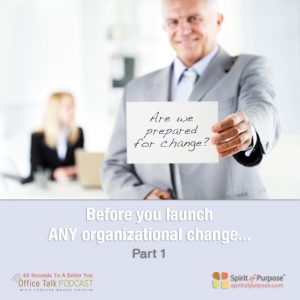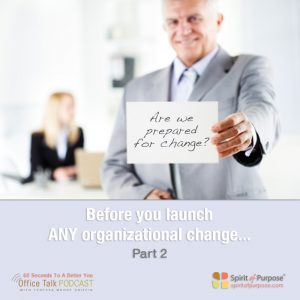PODCAST: How To Prep Your Organization For Any Change
Part 1: 3 Questions To Assess Your Organization’s Readiness
Are big changes on your company’s horizon? William and Susan Bridges, authors of “Managing Transitions: Making the Most of Change” suggest asking three questions to make things go smoothly.
- First, what is changing? When high-level leaders communicate change in a vague, abstract way, it’s hard for employees lower in the hierarchy to understand and buy in to the new vision. To address this, The Bridges suggest drafting a jargon-free, 1-minute description that describes the problem and clarifies the reasons for change.
- Next, what will actually be different? Take time to understand and explain how things will be different for the people who’ll make change work. Ignoring this reality may undermine the way teams function at a time when you need them to work well together.
- Finally, Who’s going to lose what? You might think this topic is too negative, but the Bridges assert that it affirms that you’re in touch with people’s actual experience.
Part 2: This Assessment Measures Your Organization’s Change Readiness
Some organizational changes are unavoidable. Others are driven by external forces or internal leadership’s desire to do more, better. Whatever the reason for change, it’s wise to assess how well the organization can weather the transition before it begins.
William and Susan Bridges, authors of “Managing Transition: Making the Most of Change” have a free readiness assessment tool available on their website wmbridges.com. The 25-question survey provides an honest analysis of the current state of your company. It can reveal the weak links that might derail change, allowing you the opportunity to adjust.
Encourage anyone who completes the survey to be truthful. Answers based on what’s expected or how things should be won’t give you the insight you need to navigate change effectively. The tool provides easy instructions for evaluating the responses, which will help you better position the organization and it’s people for what’s to come.



